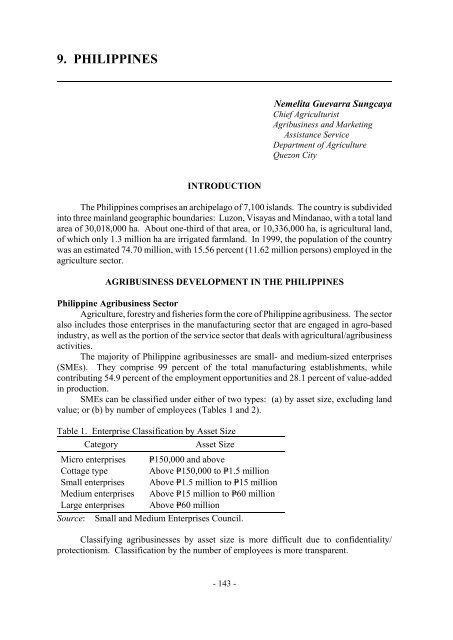Development of Agribusiness Enterprises - Asian Productivity ...
Development of Agribusiness Enterprises - Asian Productivity ...
Development of Agribusiness Enterprises - Asian Productivity ...
You also want an ePaper? Increase the reach of your titles
YUMPU automatically turns print PDFs into web optimized ePapers that Google loves.
9. PHILIPPINES<br />
INTRODUCTION<br />
- 143 -<br />
Nemelita Guevarra Sungcaya<br />
Chief Agriculturist<br />
<strong>Agribusiness</strong> and Marketing<br />
Assistance Service<br />
Department <strong>of</strong> Agriculture<br />
Quezon City<br />
The Philippines comprises an archipelago <strong>of</strong> 7,100 islands. The country is subdivided<br />
into three mainland geographic boundaries: Luzon, Visayas and Mindanao, with a total land<br />
area <strong>of</strong> 30,018,000 ha. About one-third <strong>of</strong> that area, or 10,336,000 ha, is agricultural land,<br />
<strong>of</strong> which only 1.3 million ha are irrigated farmland. In 1999, the population <strong>of</strong> the country<br />
was an estimated 74.70 million, with 15.56 percent (11.62 million persons) employed in the<br />
agriculture sector.<br />
AGRIBUSINESS DEVELOPMENT IN THE PHILIPPINES<br />
Philippine <strong>Agribusiness</strong> Sector<br />
Agriculture, forestry and fisheries form the core <strong>of</strong> Philippine agribusiness. The sector<br />
also includes those enterprises in the manufacturing sector that are engaged in agro-based<br />
industry, as well as the portion <strong>of</strong> the service sector that deals with agricultural/agribusiness<br />
activities.<br />
The majority <strong>of</strong> Philippine agribusinesses are small- and medium-sized enterprises<br />
(SMEs). They comprise 99 percent <strong>of</strong> the total manufacturing establishments, while<br />
contributing 54.9 percent <strong>of</strong> the employment opportunities and 28.1 percent <strong>of</strong> value-added<br />
in production.<br />
SMEs can be classified under either <strong>of</strong> two types: (a) by asset size, excluding land<br />
value; or (b) by number <strong>of</strong> employees (Tables 1 and 2).<br />
Table 1. Enterprise Classification by Asset Size<br />
Category Asset Size<br />
Micro enterprises P=150,000 and above<br />
Cottage type Above P=150,000 to P=1.5 million<br />
Small enterprises Above P=1.5 million to P=15 million<br />
Medium enterprises Above P=15 million to P=60 million<br />
Large enterprises Above P=60 million<br />
Source: Small and Medium <strong>Enterprises</strong> Council.<br />
Classifying agribusinesses by asset size is more difficult due to confidentiality/<br />
protectionism. Classification by the number <strong>of</strong> employees is more transparent.
















